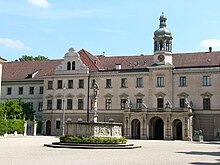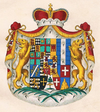Thurn und Taxis
This article includes a list of references, but its sources remain unclear because it has insufficient inline citations. (June 2008) (Learn how and when to remove this template message) |
County of Thurn and Taxis Grafschaft Thurn und Taxis | |||||||
|---|---|---|---|---|---|---|---|
| 1608–1806 | |||||||
 Coat of arms | |||||||
| Status | State of the Holy Roman Empire | ||||||
| Capital | Regensburg | ||||||
| Government | Principality | ||||||
| Historical era | Middle Ages Early modern period | ||||||
• Raised to Briefadel | 1512 | ||||||
• Raised to Reichsfreiherren | 1608 | ||||||
• Hereditary Imperial Postmaster General | 1615 | ||||||
• Raised to County | 1624 | ||||||
• Granted princely rank (Spanish Court) | 1681 | ||||||
• Princely county | 1695 | ||||||
• Mediatised to Bavaria | 1806 | ||||||
• Postal monopoly nationalised | 1867 | ||||||
| |||||||

Coat of arms of the Princes of Thurn and Taxis
The Princely House of Thurn and Taxis (German: Fürstenhaus Thurn und Taxis [ˈtuːɐ̯n ʊnt ˈtaksɪs]) is a family of German nobility that is part of the Briefadel. It was a key player in the postal services in Europe during the 16th century, until the end of the Holy Roman Empire in 1806, and became well known as the owner of breweries and builder of many castles. The current head of the house is HSH Albert II, 12th Prince of Thurn and Taxis. The family is one of the wealthiest in Germany and has resided at St. Emmeram Castle in Regensburg since 1748.
Contents
1 History
2 Princes of Thurn and Taxis
3 Cultural references
4 See also
5 References and sources
6 External links
History
The Tasso family (from the Italian word for "badger") was a Lombard family in the area of Bergamo. The earliest records place them in Almenno in the Val Brembana around 1200[1] before they fled to the more distant village of Cornello to escape feuding between Bergamo's Guelf Colleoni and the Ghibelline Suardi families. Around 1290,[2] after Milan had conquered Bergamo, Omodeo Tasso organized 32 of his relatives into the Company of Couriers (Compagnia dei Corrieri) and linked Milan with Venice and Rome.[3] The recipient of royal and papal patronage, his post riders were so comparatively efficient that they became known as bergamaschi throughout Italy.[4]
Ruggiero de Tassis was named to the court of the emperor Frederick the Peaceful in 1443. He organized a post system between Bergamo and Vienna by 1450;[2] from Innsbruck to Italy and Styria around 1460; and Vienna with Brussels around 1480.[2] Upon his success, Ruggiero was knighted and made a gentleman of the Chamber.[4][5] Jannetto de Tassis was appointed Chief Master of Postal Services at Innsbruck in 1489. Philip of Burgundy elevated Janetto's brother Francisco de Tassis (Italian) to captain of his post in 1502.[6] Owing to a payment dispute with Philip, Francisco opened his post to public use in 1506.[2] By 1516, Francisco had moved the family to Brussels in the Duchy of Brabant, where they became instrumental to Habsburg rule, linking the rich Habsburg Netherlands to the Spanish court.[6] The normal route passed through France, but a secondary route across the Alps to Genoa was available in times of hostility.
The name Thurn und Taxis arose from the translation into German of the family's French title (de La Tour et Tassis or de Tour et Taxis). Charles V named Giovanni Battista de Tassis as master of his post in 1520; Maximilian I expanded their network throughout the Holy Roman Empire.[7] In 1624, the family were elevated to grafen ("counts") and they formally adopted the German form of their name in 1650. They were named "princely" in 1695 at the behest of Emperor Leopold I. The family operated the Thurn-und-Taxis Post, successor to the Imperial Reichspost of the Holy Roman Empire, between 1806 and 1867. Their postal service was gradually lost over the centuries, with the Spanish network being bought by the crown in the 18th century and the German post being purchased by Prussia after the fall of the Free City of Frankfurt in 1866. The family seat was established in Regensburg, Germany, and has remained at St. Emmeram Castle there since 1748.

Small section of the extensive family seat at St. Emmeram Castle in Regensburg, Germany
Rainer Maria Rilke wrote his Duino Elegies while visiting Princess Marie of Thurn and Taxis (née Princess of Hohenlohe) at her family's Duino Castle. Rilke later dedicated his only novel (The Notebooks of Malte Laurids Brigge) to the princess, who was his patroness. Princess Marie's relation to Regensburg's Thurn and Taxis family is rather distant, however – she was married to Prince Alexander of Thurn and Taxis, a member of the family's Czech branch that in the early 19th century settled in Bohemia (now the Czech Republic) and became strongly connected to Czech national culture and history.
Several members of the family have been Knights of Malta.
Until 1919, the titles of the respective head of the princely house were Seine Durchlaucht der Fürst von Thurn und Taxis, Fürst zu Buchau und Fürst von Krotoszyn, Herzog zu Wörth und Donaustauf, gefürsteter Graf zu Friedberg-Scheer, Graf zu Valle-Sássina, auch zu Marchtal, Neresheim usw., Erbgeneralpostmeister (His Highness the Prince of Thurn and Taxis, Prince of Buchau and Prince of Krotoszyn, Duke of Wörth and Donaustauf, Count of Friedberg-Scheer, Count of Valle-Sássina, Marchtal, Neresheim etc., Hereditary Postmaster General).[8]
The current head of the house of Thurn and Taxis is HSH Albert II, 12th Prince of Thurn and Taxis, son of Johannes and his wife, Gloria. The family is one of the wealthiest in Germany. The family's brewery was sold to the Paulaner Group of Munich in 1996, but it still produces beer under the brand of Thurn und Taxis.
Princes of Thurn and Taxis
Princely Family of Thurn and Taxis |
|---|
 |
HSH The Prince HSH The Dowager Princess
Extended family
|
.mw-parser-output .treeview ulpadding:0;margin:0.mw-parser-output .treeview lipadding:0;margin:0;list-style-type:none;list-style-image:none.mw-parser-output .treeview li libackground:url("//upload.wikimedia.org/wikipedia/commons/f/f2/Treeview-grey-line.png")no-repeat 0 -2981px;padding-left:21px;text-indent:0.3em.mw-parser-output .treeview li li:last-childbackground-position:0 -5971px.mw-parser-output .treeview li.emptyline>ul>.mw-empty-elt:first-child+.emptyline,.mw-parser-output .treeview li.emptyline>ul>li:first-childbackground-position:0 9px
Eugen Alexander, 1st Prince 1695–1714 (1652–1714)
Anselm Franz, 2nd Prince 1714–1739 (1681–1739)
Alexander Ferdinand, 3rd Prince 1739–1773 (1704–1773)
Karl Anselm, 4th Prince 1773–1805 (1733–1805)
Karl Alexander, 5th Prince 1805–1827 (1770–1827)
Maximilian Karl, 6th Prince 1827–1871 (1802–1871)
Maximilian Anton, Hereditary Prince of Thurn and Taxis (1831–1867)
Maximilian Maria, 7th Prince 1871–1885 (1862–1885)
Albert I, 8th Prince 1885–1952 (1867–1952)
Franz Joseph, 9th Prince 1952–1971 (1893–1971)- Prince Gabriel (1922–1942)
Karl August, 10th Prince 1971–1982 (1898–1982)
Johannes Baptista, 11th Prince 1982–1990 (1926–1990)
Albert II, 12th Prince 1990–present (born 1983)
Prince Raphael Rainer (1906–1993)
(1) Prince Max Emanuel (born 1935), heir presumptive, two sons without dynastic rights
Prince Philipp Ernst (1908–1964)
(2) Prince Albrecht Friedrich (born 1930)
Prince Maximilian Joseph (1769–1831), founder of the Czech branch of the family
Prince Karl Anselm (1792–1844)
Prince Hugo Maximilian (1817–1889)
Prince Alexander Johann (1851–1939)
Prince Erich Lamoral (1876–1952)
Prince Johann von Nepomuk (1908–1959)
(3) Prince Friedrich (born 1950)
(4) Prince Karl Ferdinand (born 1952), three sons without dynastic rights
(5) Prince Maximilian (born 1955)
- Prince Alexander (1881–1937), 1st Principe della Torre e Tasso and Duke of Castel Duino 1923–1937, heirs without dynastic rights
The Thurn and Taxis family came to massive media attention during the late 1970s through mid-1980s when the late Prince Johannes married Countess Mariae Gloria of Schönburg-Glauchau, a member of an impoverished but mediatized noble family. The couple's wild, "jet set" lifestyle and Princess Gloria's over-the-top appearance (characterized by bright hair colours and avant-garde clothes) earned her the nickname of "Princess TNT".[9]
Cultural references
- The mail monopoly of Thurn and Taxis is central to the plot of The Crying of Lot 49 by Thomas Pynchon.
- The board game Thurn and Taxis, by Andreas Seyfarth and Karen Seyfarth, is inspired by the family.
- The protagonist of Walter Jon Williams's Elegy for Angels and Dogs is the head of the Thurn und Taxis family.
- Thurn und Taxis are also mentioned in several volumes of the 163x series by Eric Flint and others, e.g. 1635: The Dreeson Incident and 1636: The Saxon Uprising.
- The credits for Season 3, Episode 4 of the television show The Good Place features a character named "The Baroness von Thurn und Taxis," played by Ilka Urbach.
See also
- Brussels' Tour & Taxis
- Czech branch of the House of Thurn and Taxis
- Donaustauf Castle
Dukes of Castel Duino, an Italian branch- House of Thurn and Taxis line of succession
- Order of Parfaite Amitié
- Thurn-und-Taxis Post
References and sources
- Notes
^ Serassi, Pierantonio. La vita di Torquato Tasso, pp. 4 ff. Pagliarini, 1785. Accessed 2 October 2013. (in Italian)
^ abcd The Encyclopedia Americana: The International Reference Work, Vol. 25, p. 476. Utgiver Americana Corporation, 1958. Accessed 3 October 2013.
^ Turismo Lombardia. "Il Borgo di Camerata Cornello dei Tasso Archived 2013-10-04 at the Wayback Machine.". Accessed 3 October 2013. (in Italian)
^ ab López Jurado, Luis Felipe. Prefilatelia de Murcia: Historia Postal del Reino de Murcia desde 1569 hasta 1861, pp. 26 ff. "La Familia Tassis". Editora Regional de Murcia, 2006. Accessed 3 October 2013. (in Spanish)
^ Le Folklore Brabancon, p. 372.
(Brabant), 1981. Accessed 3 October 2013. (in French)
^ ab Papadopoulos, A.G. Urban Regimes and Strategies: Building Europe's Central Executive District in Brussels (University of Chicago Press, 1996), p. 41. Accessed 3 October 2013.
^ McRobbie, L. R. Gute Prinzessinnen kommen ins Märchen, böse schreiben Geschichte: Von Olga, der Wilden, über Kaiserin Sisi bis zu Gloria von Thurn und Taxis. BTB Verlag, 2014.
^ Genealogisches Handbuch des Adels, Fürstliche Häuser. Band XV, Limburg/Lahn 1997, S. 474.
^ Princess TNT Archived 2007-10-26 at the Wayback Machine. (also referred to as "Princess TNT, the dynamite socialite") according to the June 2006 edition of Vanity Fair Magazine).
- Sources
- Wolfgang Behringer, Thurn und Taxis, Die Geschichte ihrer Post und ihrer Unternehmen, München, Zürich 1990 .mw-parser-output cite.citationfont-style:inherit.mw-parser-output qquotes:"""""""'""'".mw-parser-output code.cs1-codecolor:inherit;background:inherit;border:inherit;padding:inherit.mw-parser-output .cs1-lock-free abackground:url("//upload.wikimedia.org/wikipedia/commons/thumb/6/65/Lock-green.svg/9px-Lock-green.svg.png")no-repeat;background-position:right .1em center.mw-parser-output .cs1-lock-limited a,.mw-parser-output .cs1-lock-registration abackground:url("//upload.wikimedia.org/wikipedia/commons/thumb/d/d6/Lock-gray-alt-2.svg/9px-Lock-gray-alt-2.svg.png")no-repeat;background-position:right .1em center.mw-parser-output .cs1-lock-subscription abackground:url("//upload.wikimedia.org/wikipedia/commons/thumb/a/aa/Lock-red-alt-2.svg/9px-Lock-red-alt-2.svg.png")no-repeat;background-position:right .1em center.mw-parser-output .cs1-subscription,.mw-parser-output .cs1-registrationcolor:#555.mw-parser-output .cs1-subscription span,.mw-parser-output .cs1-registration spanborder-bottom:1px dotted;cursor:help.mw-parser-output .cs1-hidden-errordisplay:none;font-size:100%.mw-parser-output .cs1-visible-errorfont-size:100%.mw-parser-output .cs1-subscription,.mw-parser-output .cs1-registration,.mw-parser-output .cs1-formatfont-size:95%.mw-parser-output .cs1-kern-left,.mw-parser-output .cs1-kern-wl-leftpadding-left:0.2em.mw-parser-output .cs1-kern-right,.mw-parser-output .cs1-kern-wl-rightpadding-right:0.2em
ISBN 3-492-03336-9 - Martin Dallmeier, Quellen zur Geschichte des europäischen Postwesens, Kallmünz 1977
- Martin Dallmeier and Martha Schad, Das Fürstliche Haus Thurn und Taxis, 300 Jahre Geschichte in Bildern, Regensburg 1996,
ISBN 3-7917-1492-9 - Fritz Ohmann, Die Anfänge des Postwesens und die Taxis, Leipzig 1909
- Joseph Rübsam, Johann Baptista von Taxis, Freiburg im Breisgau 1889
- Marecek, Zdenek, Loucen a Thurn Taxisove. Pohledy do doby minule i nedavne. Obec Loucen, 1998.
External links
| Wikimedia Commons has media related to Thurn und Taxis family. |
- Thurn und Taxis family website
- Pedigrees of Thurn und Taxis family
Old German States Stamps Altdeutschland – link to the postage stamps Thurn und Taxis issued, 1852-67

